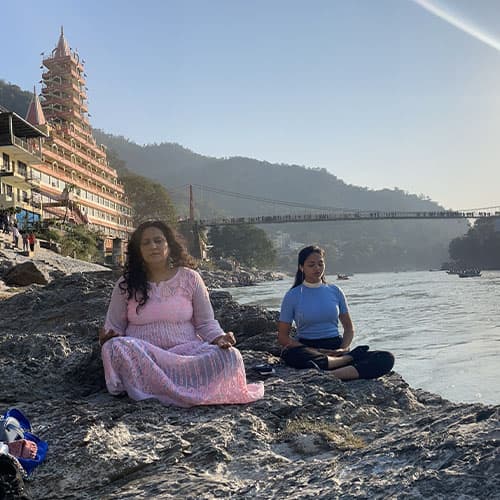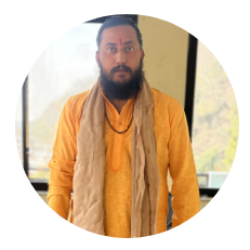
HOW IS TM DIFFERENT FROM OTHER FORMS OF MEDITATION?
The main difference between TM and other forms of meditation – it is effortless and automatic - it allows the thoughts to come and go rather than emptying the mind of all the thoughts. In TM, the mantra is a meaningless sound used as a vehicle to help the mind settle down. By repeatedly reciting the mantra, a meditator aims to still the activity of thought and to experience a state of stillness and consciousness, which leads to enhanced creativity, contentment and vitality. While some meditation practices focus on controlling the thoughts, TM uses the natural tendency of the mind. The theoretical perspective behind TM is based on Vedanta philosophy.
HISTORY OF TRANSCENDENTAL MEDITATION
TM was taught by Swami Brahmananda Saraswati, a Hindu monk also known as Guru Dev (died 1953). In the late 1950s, it was introduced across the globe by Maharishi Mahesh Yogi, one of his disciples. He named the traditional meditation technique taught by his guru "Transcendental Deep Meditation". Later he renamed this technique, Transcendental Meditation to distinguish the technique from other meditation practices and emphasis its independence from Hinduism. Internationally, TM eventually came to be taught and practiced as a secular path toward mental, emotional, and physical well-being.
From 1958 to 1959, Maharishi taught the TM technique in Burma (Myanmar), Hawaii, Los Angeles, San Francisco, Germany and London. The Spiritual Regeneration Movement was founded by Maharishi in Los Angeles and taught TM in the USA between 1959 and 1965. The first International Teacher Training Course (TTC) of TM was started by him in Rishikesh, India. Over 60 practitioners from India, Canada, Germany, Britain, Denmark, Norway, Malaya, Australia, the United States, Italy, Greece and the West Indies attended the course. The Maharishi also started teaching advanced mental techniques known as the TM-Sidhi Program, which was believed to create the Maharishi Effect. In the late 1970s, the popularity of the TM increased significantly, when the British rock group “The Beatles” and other celebrities came all the way to India to the ashram of Maharishi to learn meditation.

7 STEPS OF TRANSCENDENTAL MEDITATION
To practice TM, a student must first be initiated by a teacher. A certified TM teacher teaches this seven-step course in six days. A TM teacher trains and instructs students via private as well as group instruction.
- The one-hour introductory lecture involves instruction that prepares students for subsequent steps. This lecture discusses mind potential, social relationships, health and promoting inner and outer peace.
- A Preparatory lecture is a 45-minute session that covers the theory of the practice, its origins and its relationship to other types of meditation.
- The third step is a ten-minute private session or personal interview, a teacher to get acquainted with students and answer questions. The personal instruction lasts for 1-2 hours, students are asked to come up with a clean handkerchief, flowers and fruits, and their course fee. The session begins with a short prayer ceremony performed by the teacher. The purpose of conducting this ceremony is to show respect and gratitude to the lineage of TM masters or holy Tradition. A teacher recites a text in Sanskrit. Post the ceremony, students receive their mantra, which is selected by the teacher on the basis of the person’s temperament and occupation. The practitioner then starts meditating independently morning and evening for 20 minutes
- The 4-7th steps involve follow-up and checking sessions: Next day after the personal instruction session, there are three subsequent “checking” sessions, in which the person meditates under the teacher’s observation. Each session lasts for 90-120 minutes. It occurs on 3 consecutive days, called 3 days of checking. The purpose of these sessions is to verify the correctness of the practice and to receive further instruction. On the second day of checking, more details of the mechanics and potential results of the practice of TM is done. The third day of checking focuses on subjective development and the potential growth of higher stages of human consciousness. For new meditators, there are private follow-up sessions to confirm if they are practicing the technique correctly, a process named “personal checking”. It is a 30-minute session once per week for a month, and once per month thereafter. The purpose of checking sessions or follow-up is to verify the practice, for one-on-one interaction with a TM teacher, and to address any sort of query. A lifetime follow-up program is accessible to students which involve consultations, "refresher courses", advanced lectures and group meditations. Students can further join advanced courses including weekend Residence Courses and the TM-Sidhi program.
HOW TO DO TM?
- You can choose any easy and comfortable sitting posture or sit in a comfortable chair.
- Close your eyes, and take a few deep breaths to relax your body.
- Gently open your eyes, and then close them again. Your eyes will remain closed during the 20-minute practice.
- Repeatedly recite a mantra in your mind. This mantra is a Sanskrit sound learned from a TM teacher.
- When you’re having random thoughts, simply return to the mantra.
- After 20 minutes, begin to move your fingers and toes to ease yourself back into the world.
- Gently open your eyes
- Sit for a while until you are ready to continue your day.
HOW TO DO TM?
- You can choose any easy and comfortable sitting posture or sit in a comfortable chair.
- Close your eyes, and take a few deep breaths to relax your body.
- Gently open your eyes, and then close them again. Your eyes will remain closed during the 20-minute practice.
- Repeatedly recite a mantra in your mind. This mantra is a Sanskrit sound learned from a TM teacher.
- When you’re having random thoughts, simply return to the mantra.
- After 20 minutes, begin to move your fingers and toes to ease yourself back into the world.
- Gently open your eyes
- Sit for a while until you are ready to continue your day.

BENEFITS OF TM
Experts agree that everyone can get something positive from Transcendental Meditation. Many psychologists and scientific studies claimed that by practicing this simple technique of meditation one can keep many physical as well mental ailments at bay.
REDUCED ANXIETY & DEPRESSION
Practicing TM on regular basis helps to reduce worrying thoughts and bring a feeling of balance, calm and focus. Transcendental Meditation overcome stress and anxiety by reducing the level of the stress hormone, cortisol, secreting more serotonin.
IMPROVED CARDIOVASCULAR HEALTH
High Blood Pressure leads to poor heart health like atherosclerosis or a narrowing of the arteries which leads to the risk of heart attack & stroke. Transcendental Meditation helps to control blood pressure.
MORE ENERGY
By practicing Transcendental Meditation, one can turn one’s body into a powerhouse by generating inner source of energy. It has power to boost your energy levels and takes your body to a state of deep rest and rejuvenation
ENHANCED CREATIVITY & INTELLECTUAL ABILITIES
Transcendental Meditation clears the mind which leads to better ideas, better decision making and a better mood. Holistic functioning of brain parts; increased intelligence enhancing creativity and other intellectual abilities.
FIGHTS INSOMNIA
Regular practice of TM decreases sleeplessness and improves the quality of sleep. Becoming skilled in TM helps you to redirect the racing or runway of thoughts that lead to insomnia. It helps to relax the body and gives a deeper quality of sleep.
IMPROVES PAIN MANAGEMENT
Incorporating Transcendental Meditation into your routine could be beneficial for regulating pain. The practitioner of TM has a greater ability to cope with pain and even experienced a reduced sensation of pain
DECREASE MENOPAUSAL SYMPTOMS
Many women face post menopause symptoms such as hot flashes, irritability, mood changes, anxiety and depression. Transcendental Meditation is highly effective in reducing menopause associated symptoms during the late menopausal transition.
GREATER CLARITY OF THOUGHTS
With the consistent practice of TM one can keep random thoughts and doubts out of the head. A clear mind leads to greater positivity, productivity and contentment. TM makes you more focused, away from distraction, and free of self-doubts.


